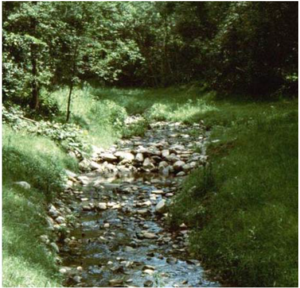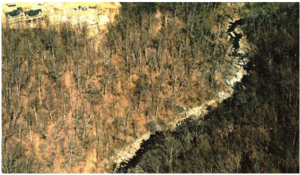
MS4 fact sheet - Establishing a Buffer Ordinance
Conservation buffers are small areas or strips of land in permanent vegetation, designed to intercept pollutants and manage other environmental concerns. Examples of buffers include: riparian/wetland buffers, filter strips, grassed waterways and vegetative barriers. An ordinance that requires buffers around water resources can effectively remove additional pollutants and protect downstream resources, as well as provide aquatic and terrestrial habitat.
This fact sheet provides guidance on developing and implementing a buffer ordinance.
Contents
Benefits / pollution reduction
Buffers can provide many different environmental and economic benefits, including the following.
- Reduced small drainage problems and complaints
- Reduced risk of flood damage
- Reduced stream bank erosion
- Increased adjacent property values
- Enhanced pollutant removal
- Location for greenways and trails
- Sustained integrity of stream ecosystems and habitat
- Protection of wetlands associated with the stream corridor
- Prevention of disturbance of steep slopes
- Mitigation of stream warming
- Protection of important stream corridor habitat for wildlife
Water quality improvement and protection will vary based on the ordinance developed. An ordinance that requires a 100-foot buffer versus a 20 foot buffer will have higher pollutant removals. Pollutant removal studies have determined a 63 to 89 percent removal of total suspended solids (TSS) and 41 to 78 percent removal of total phosphorus (TP) for buffers that are between 4.6 and 26 meters wide (Aquatic Buffers Fact Sheet: Buffer Zones, Center for Watershed Protection).
Program development and implementation
Buffer ordinance
MS4s can adopt regulations wherein owners or developers are required to implement buffers under certain conditions. Conditions could be based on proximity to streams, lakes and wetlands, to waters of the United States, to DNR public waters or based on the functions and values of water bodies as identified by the MS4. The EPA provides model ordinance guidance for buffers and recommends the ordinance framework adapted below.
- Background Identify the functions and benefits of buffers.
- Intent Establish the intent to require the design and implementation of buffer installations.
- Definitions Define key terms.
- Applications Identify the activities and applications to which the ordinance applies.
- Plan requirements Identify the content and submittal requirement for the buffer plan.
- Design standards Define the design standards including width or area, slope and vegetative cover. Establish a minimum width that would apply to all buffers, and then customize requirements according to functions, values, and perhaps size of the water body. Determine how areas are to be calculated and identify any flexibility in the standard, such as using an average buffer width to meet the standard. This would also allow changes to be made to adjust for such factors as steep slopes, poor soils, encroaching land uses or sensitivity of the water body. Standards should also provide specifications for different vegetative mixes based on a set of site conditions (e.g. slope, soils and climatic region), require signage, and specify a minimum spacing of signage (ex. every 50 feet) to identify the buffer and prevent encroachment. Especially in early spring, the untrained eye can mistake buffers for lawn. See the Vegetated Swales and Buffer Strips fact sheet for additional design information.
- Buffer management and maintenance Define the management and maintenance standards. Maintenance of buffer areas is essential to their proper long-term operation. Special attention should be paid to preventing concentrated stormwater discharges, maximizing distribution of runoff as sheet flow, removing accumulations of pollutants, keeping vegetation healthy and keeping soils porous. An annual maintenance for buffer areas would help to assure continued success as an integral part of the overall stormwater management program. Buffers that are kept healthy will maintain their physical filtering and chemical uptake characteristics.
- Enforcement procedures: Identify the penalties for violations and the program responsible for detecting violations.
- Waivers and variances Specify the conditions under which waivers or variances apply. Flexibility could be introduced through buffer averaging, clustering or conservation easements.
- Conflicts with other regulations Identify that the more restrictive regulation applies when the ordinance conflicts with other regulations.
- References Site all references used to develop the ordinance or rule.
Awareness campaigns
Awareness campaigns inform public employees, businesses, property owners, and elected officials on the benefits of buffers. Efforts can contribute to generating acceptance of the new ordinance or encouraging individuals and organizations to implement buffers on a voluntary basis. Suggested educational methods include:
- Brochures Develop informative brochures, and guidance for specific audiences such as businesses, homeowners associations and garden clubs.
- Signage at MS4 installations Locate signage at parks and government buildings identifying the conservation buffer and its functions and benefits.
- Workshops and seminars Workshops and seminars can be used to provide the technical assistance that developers, staff and consultants will need in order to meet the new buffer ordinance.
Monitoring and assessment
The MS4, or the municipality in cooperation with other buffer interests, could engage in documenting the effectiveness of its buffer approach by conducting monitoring to see what water quality and other benefits are accomplished. Findings could provide feedback for maintenance requirements and ordinance revisions. Buffer monitoring could include the following activities: identification or measurement of encroachment by adjacent property owners, water quantity and quality monitoring (e.g. nutrients, temperature, heavy metals) at various locations in downstream water bodies, botanical surveys including identification of species cover and composition, and mapping of overall acreage of buffers implemented through the buffer ordinance.
Maintenance considerations
Maintenance of a buffer ordinance requires periodic review and revision based on new technology, new research or feedback from implementation of the ordinance. Typical buffer maintenance activities include remediation of any channelization that may have developed, removal of accumulated pollutants or trash, weed control or other tasks that maintain healthy vegetation, and aeration or other mitigation to maintain the high pervious quality of the soil.
Typical cost
The adoption of a buffer ordinance requires an investment in training for the plan reviewer, the consultant, and possibly the public. Time consuming elements include research, functions and values assessments, and educating decision makers. MS4s must also consider the cost of enforcement, including staff and equipment requirements. Awareness campaign costs are determined by the type of materials produced and the method of distribution selected. Signs at public buffer installations may initially have a higher cost than printed materials, but can serve as a more effective tool for increasing public understanding. Assessments should include the reasonable cost of the land used to establish buffers.
This page was last edited on 22 November 2022, at 18:32.

